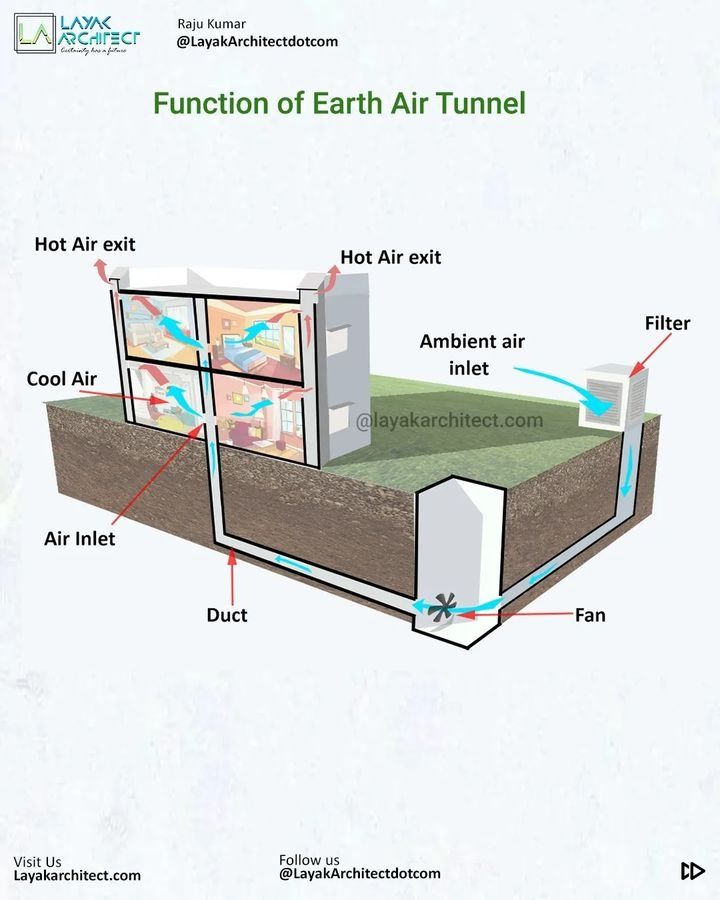As energy costs soar and climate change intensifies, architects are reviving Earth Air Tunnels—a natural, low-cost solution for cooling and heating buildings by harnessing the stable temperature of the ground.
Article
In the age of high-tech air conditioning systems and energy-hungry buildings, an ancient principle buried beneath our feet is gaining fresh attention. Known as Earth Air Tunnels (EATs) or Earth-to-Air Heat Exchangers, this passive cooling and heating technique is being hailed as a sustainable alternative to conventional HVAC systems.
With rising global temperatures and an urgent push to reduce carbon emissions, the Earth Air Tunnel offers a simple yet powerful solution: using the ground itself to regulate indoor temperatures.
🌍 The Concept: Cooling and Heating with Soil
The idea behind Earth Air Tunnels is straightforward yet ingenious. Just a few meters below the earth’s surface, temperatures remain relatively constant throughout the year—cooler than the outside air in summer and warmer in winter.
By channeling ambient air through underground pipes or ducts, buildings can naturally cool down during scorching summers or warm up in freezing winters. The process requires little more than a fan to move the air and filters to keep it clean.
The result? Comfortable indoor climates with drastically reduced reliance on air conditioners or heaters.
🏠 How It Works: Step by Step
The diagram of the Earth Air Tunnel system reveals a process that is both simple and elegant:
- Ambient Air Inlet: Fresh outdoor air enters through a filtered opening.
- Ducts Underground: The air is funneled into long underground ducts, typically buried 3 to 4 meters below the surface, where the soil temperature is stable.
- Cooling or Heating: As the air travels through the ducts, it exchanges heat with the surrounding soil—losing excess heat in summer or gaining warmth in winter.
- Fan Support: A fan helps move the conditioned air through the tunnel and into the building.
- Indoor Circulation: The cooled or warmed air is distributed throughout the interior, maintaining a pleasant indoor environment.
- Hot Air Exit: Stale or warm air exits through vents, ensuring circulation.
In essence, the ground acts as a natural air conditioner and heater, powered by nothing more than soil, air, and a small amount of electricity.
⚡ Energy Savings and Environmental Benefits
The biggest appeal of Earth Air Tunnels lies in their energy efficiency. Traditional air conditioning systems can consume 30–50% of a building’s energy, whereas Earth Air Tunnels slash this consumption dramatically.
- Energy Savings: Studies show that EATs can reduce energy use by up to 80% for cooling and 60% for heating.
- Carbon Footprint: Lower energy consumption means fewer greenhouse gas emissions.
- Cost Efficiency: While the initial installation can be costly, long-term savings on electricity bills are significant.
With climate change pushing global temperatures higher, Earth Air Tunnels offer a low-carbon, future-ready alternative for thermal comfort.
🌡️ Performance in Different Seasons
- Summer: In regions where outdoor temperatures soar above 40°C (104°F), EATs can deliver air cooled to 25–28°C (77–82°F), drastically reducing the load on air conditioners or even eliminating the need for them.
- Winter: In cold regions, air passing through underground ducts emerges warmer than the freezing air outside, making interiors more comfortable without heavy use of heaters.
This adaptability makes Earth Air Tunnels especially useful in countries with extreme climates, such as India, the Middle East, or parts of Africa.
🏛️ From Ancient Wisdom to Modern Engineering
The principle behind Earth Air Tunnels is not new. Ancient civilizations, including the Persians and Romans, used underground air channels for passive cooling. Known as qanats or wind catchers, these systems provided natural ventilation in arid climates for centuries.
Today’s engineers are simply refining these age-old practices with modern materials and design precision. Instead of mud tunnels, we now use PVC or concrete pipes, filters, and fans to optimize airflow and improve hygiene.
📌 Case Studies Around the World
- India: In states like Rajasthan and Gujarat, Earth Air Tunnels are being integrated into schools, offices, and even metro stations to reduce dependence on costly air conditioning.
- Germany: Eco-housing projects often employ EATs to achieve energy neutrality, paired with solar panels and insulation.
- Middle East: Reviving traditional passive cooling methods, architects are blending Earth Air Tunnels with modern sustainable design.
These examples prove that the system is not limited to one geography—it’s a global solution with local adaptability.
🛠️ Challenges and Limitations
Despite their promise, Earth Air Tunnels are not without challenges:
- Initial Cost: Excavation and installation of underground ducts can be expensive.
- Maintenance: Ducts must be kept clean and dry to prevent mold or bacteria buildup.
- Climate Suitability: Works best in areas with large differences between outdoor and underground temperatures.
- Land Requirement: Requires sufficient space for underground tunneling, making it less feasible in dense urban cores.
Yet, as energy prices rise and governments push for green building codes, many experts argue these challenges are minor compared to the long-term sustainability benefits.
🔮 The Future of Cooling and Heating
The revival of Earth Air Tunnels is part of a larger movement toward passive architecture—designing buildings that work with nature rather than against it. Alongside green roofs, rainwater harvesting, and solar panels, EATs are becoming a vital component of sustainable architecture.
In smart cities of the future, where energy efficiency and climate resilience are paramount, Earth Air Tunnels could become standard practice in building design.
As Raju Kumar, an architect advocating for sustainable systems, notes:
“We don’t always need machines to solve problems. Sometimes, the Earth itself has the answers—we just have to listen.”
🌱 Conclusion
Earth Air Tunnels represent a remarkable blend of ancient wisdom and modern engineering. They demonstrate how working with natural processes can help us achieve thermal comfort without harming the planet.
As the world struggles to cut carbon emissions while ensuring livable conditions, Earth Air Tunnels may well become a cornerstone of sustainable housing and commercial development.
In a warming world, the path forward might just be underground.
